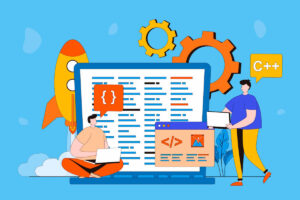Low code platforms have been gaining popularity in recent years as they allow developers to quickly build applications with minimal coding. When it comes to PHP low code platforms, there are several key features that set them apart from traditional development tools. In this article, we will take a detailed look at these features and how they can benefit developers.
1. Drag-and-Drop Interface
One of the most prominent features of PHP low code platforms is the drag-and-drop interface. This allows developers to easily create and customize their applications by simply dragging and dropping components onto a canvas. This makes the development process much faster and more intuitive, as developers can visually see how their applications will look and function in real-time.
- The drag-and-drop interface enables developers to design their applications visually, making it easier to create user-friendly interfaces.
- Developers can rearrange components and elements with ease, allowing for quick iterations and changes to the application layout.
- The intuitive nature of the drag-and-drop interface reduces the learning curve for new developers, making it accessible to a wider range of users.
2. Pre-Built Templates and Components
PHP low code platforms often come with a library of pre-built templates and components that developers can use to quickly assemble their applications. These templates and components can range from simple buttons and forms to more complex features like user authentication and database integration. By using these pre-built elements, developers can save time and effort in building out common features of their applications.
- The pre-built templates and components provide a foundation for developers to start building their applications without starting from scratch.
- Developers can customize these templates to suit their specific needs, speeding up the development process even further.
- The availability of a variety of components ensures that developers can create visually appealing and feature-rich applications without extensive coding.
3. Code Generation
While low code platforms are designed to minimize the amount of manual coding required, developers still have the option to customize and extend their applications with custom code. PHP low code platforms often provide tools for code generation, allowing developers to quickly generate PHP code for specific functions or features. This hybrid approach gives developers the flexibility to add custom functionality while still benefiting from the speed and ease of low code development.
- Code generation tools enable developers to add custom functionality without the need to write code from scratch, saving time and effort.
- Developers can generate code snippets for common tasks or features, reducing the chances of errors and ensuring consistency in the codebase.
- The ability to mix low code development with custom coding allows developers to tailor their applications to specific requirements while maintaining the benefits of rapid development.
4. Integration with Third-Party Services
Another key feature of PHP low code platforms is their ability to easily integrate with third-party services and APIs. This allows developers to leverage the functionality of external services, such as payment gateways or social media platforms, without having to write complex integration code. By connecting their applications to these services, developers can enhance the user experience and add new features with minimal effort.
- Seamless integration with third-party services enables developers to add advanced functionality to their applications without reinventing the wheel.
- Developers can leverage the capabilities of established services to enhance the performance and user experience of their applications.
- The integration with third-party services streamlines the development process and reduces the time and effort required to implement complex features.
5. Built-In Testing and Deployment Tools
To ensure the quality and reliability of their applications, PHP low code platforms often come with built-in testing and deployment tools. These tools allow developers to test their applications for bugs and performance issues before deploying them to production. By catching and fixing issues early in the development process, developers can save time and avoid costly errors down the line.
- Built-in testing tools enable developers to conduct thorough testing of their applications, ensuring a high level of quality and performance.
- Developers can automate testing processes to identify and resolve issues quickly, leading to more efficient development cycles.
- Deployment tools streamline the process of releasing applications to production, reducing the risk of deployment errors and ensuring a smooth transition to live environments.
Conclusion
In conclusion, PHP low code platforms offer a range of features that make application development faster, easier, and more efficient. From drag-and-drop interfaces to pre-built templates and components, these platforms provide developers with the tools they need to quickly create robust and feature-rich applications. By leveraging the power of low code development, developers can streamline their workflows, enhance collaboration, and deliver high-quality applications to their users.
Ready to build faster with a PHP low-code platform? Contact us today to discuss your project and see how we can help!
FAQs:
1. What is the drag-and-drop interface feature in PHP low code platforms?
The drag-and-drop interface feature in PHP low code platforms allows developers to easily create and customize applications by dragging and dropping components onto a canvas.
2. How do pre-built templates and components benefit developers in PHP low code platforms?
Pre-built templates and components in PHP low code platforms help developers quickly assemble applications, saving time and effort in building common features like buttons, forms, user authentication, and database integration.
3. Can developers customize their applications with custom code in PHP low code platforms?
Yes, developers have the option to customize and extend their applications with custom code in PHP low code platforms, often using code generation tools to quickly generate PHP code for specific functions or features.
4. How do PHP low code platforms integrate with third-party services?
PHP low code platforms can easily integrate with third-party services and APIs, allowing developers to leverage external functionality like payment gateways or social media platforms without writing complex integration code, enhancing the user experience with minimal effort.












+ There are no comments
Add yours